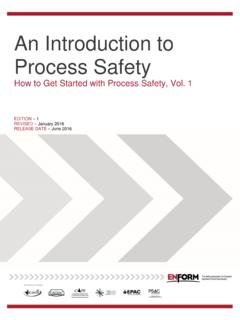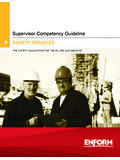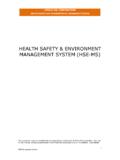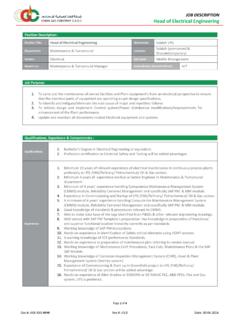Transcription of A Barrier Focused Approach - enform.ca
1 A Barrier Focused Approach How to Get Started with process safety , Vol. 2 EDITION 1 REVISED January 2016 RELEASE DATE DRAFT ENDORSEMENT This document was developed by industry for industry. Enform gratefully acknowledges the support of the endorsing organizations in the development of this document. Canadian Association of Geophysical Contractors (CAGC) Canadian Association of Oilwell Drilling Contractors (CAODC) Canadian Association of Petroleum Producers (CAPP) Canadian Energy Pipeline Association (CEPA) Explorers and Producers Association of Canada (EPAC) Petroleum Services Association of Canada (PSAC) ABOUT ENFORM Enform is the upstream oil and gas industry s advocate and leading resource for the continuous improvement of safety performance. Our mission is to help companies achieve their safety goals by providing practices, assessment, training, support, metrics and communication. AVAILABILITY This document as well as future revisions and additions, is available from: Enform Canada 5055-11 Street NE Calgary, Alberta T2E 8N4 Phone: Toll Free: Fax: Website: ACKNOWLEDGEMENT Enform gratefully acknowledges the many individuals who volunteered their time and effort to complete this document.
2 DISCLAIMER This document is intended to be flexible in application and provide guidance to users rather than act as a prescriptive solution. Recognizing that one solution is not appropriate for all users and situations, it presents generally accepted guidelines that apply to industry situations, as well as recommended practices that may suit a company s particular needs. While we believe that the information contained herein is reliable under the conditions and subject to the limitations set out, Enform does not guarantee its accuracy. The use of this document or any information contained will be at the user s sole risk, regardless of any fault or negligence of Enform and the participating industry associations. COPYRIGHT/RIGHT TO PRODUCE Copyright for this document is held by Enform, 2015. All rights reserved. Enform encourages the copying, reproduction and distribution of this document to promote health and safety in the workplace, provided that Enform is acknowledged. However, no part of this publication may be copied, reproduced or distributed for profit or other commercial enterprise, nor may any part be incorporated into any other publication, without the written permission of Enform.
3 Enform A Barrier Focused Approach i Table of Contents Introduction .. 1 The Swiss Cheese Model .. 3 Preparation .. 4 Identify the Major Hazards / High Consequence Events .. 6 Identify Controls .. 8 Identify the Critical Controls .. 10 Document the Essentials for Critical Controls .. 11 Assign Accountability for Critical Controls .. 13 Implement and Monitor the Critical Controls .. 15 Respond to Inadequate Performance .. 17 Appendix 1: The BP Swiss Cheese Model of the Macondo Incident .. 19 Appendix 2: Examples of Major Hazards / High Consequence Events .. 20 Appendix 3: A Step by Step Guide to Facilitating a Bowtie Building Session .. 21 Appendix 4: Additional Bowtie Elements .. 28 Appendix 5: Some Advanced Tips for Bowtie Development .. 29 Appendix 6: Sample Bowties from Industry Workshops .. 30 Appendix 7: Template and Sample of Simplified Critical Control Documentation .. 34 Appendix 8: The Hierarchy of Controls Applied to Fire and Explosion Hazards .. 36 Appendix 9: Advanced process Hazard Assessment (PHA) Methodologies.
4 38 Enform A Barrier Focused Approach ii Preface Purpose The purpose of the How to Get Started with process safety library of documents is to provide practical steps for companies in the oil and gas industry managing process safety risks (as process safety risks). While managing risks that are process safety risks is not new to the industry, for some companies managing these risks under the banner of process safety is new. This library is designed to help companies rapidly understand what is meant by process safety and assist them in identifying their most significant process safety risk as well as their existing management components and operational practices that fall under process safety management. This volume, A Barrier Focused Approach , provides a step by step guide for a company interested in managing its most significant process safety risks or major accident hazards. It provides practical advice on how to identify these hazards and their controls and then enhance awareness, accountability and active monitoring of these critical controls.
5 How to Use This Document The intended audience for some elements of this document is senior management or senior operational managers who carry risk management responsibilities. This would also include, but not be limited to, those specifically assigned senior roles in either process safety or, more likely, assigned health, safety , and environmental (HSE) roles. It should also be of interest to anyone assigned the task of developing and/or implementing process safety for an organization in the oil and gas industry. The actual step-by-step guidance on developing a critical control management program within a company would be of prime value to anyone assigned a key role in the development and implementation of this type of program. Limitations This document does not represent an industry standard on process safety . process safety as a discipline and process safety management practices are established in a number of well known standards. This document and the How to Get Started library are limiting themselves to offering advice on the practical demands of process safety implementation.
6 Enform A Barrier Focused Approach 1 Introduction There is no one right way to get started on a journey to process safety maturity. Every company must decide what strategy will be most effective for them when it comes to improving their process safety management. The Benefits The Barrier Focused Approach that is outlined in this document has the potential to deliver the following benefits: It leverages existing, in house knowledge and experience. It is readily scaled the effort required usually scales with the size of company and complexity of the operation(s). It goes directly to identifying and controlling the most significant hazards or risks rather than starting with supporting elements. It enables effective communication of an operation s risks and controls for all involved from senior management on through front line workers. It enables effective communication between companies working together on an operation or worksite. Where contracting and operating companies share safety systems, it allows both parties to speak a common language on process safety .
7 It creates appropriate levels of accountability for process safety from the front line on through to senior management. It provides a practical platform to measure success in process safety management (before a major incident occurs). The Barrier Focused Approach draws on standard process safety concepts. If a company selects this Approach , it should integrate with an existing, developing, or yet-to-be developed process safety management system . This Approach has been adopted by the International Council on Mining and Metals (Health and safety Critical Control Management: Good Practice Guide) and variations of this Approach already exist within upstream oil and gas companies. Who Can Benefit Any company engaged in hazardous operations may benefit from a Barrier Focused Approach . The prime audience in mind here are companies with the following characteristics: Have experienced technical personnel with a deep understanding of their operations and their inherent risks Have an existing operating history with lessons learned along the way Have existing expertise in the industry standard controls for the operations they conduct Have existing management system(s) ( , QA/QC, HSE, Operational Excellence , etc.)
8 That are already functional and capable of being applied and referenced with respect to barriers /controls Enform A Barrier Focused Approach 2 Have not been directly engaged in a traditional process hazard assessment (PHA) exercise ( , HAZOP, FMEA, FTA, ETA, LOPA, etc.) Companies that have a longer history with traditional process safety elements and PHAs may still wish to consider the benefits of the Barrier Focused Approach outlined here. For these companies, the qualitative Approach of identifying top events and barriers (especially with a bowtie diagram) may well be familiar as a final step in a more detailed quantitative risk assessment process . These companies may still wish to consider the value of the simplified critical control documentation, accountability, and monitoring suggested in the following pages for their most important controls. Enform A Barrier Focused Approach 3 The Swiss Cheese Model The Barrier Focused Approach is based on an established theory of accident causation popularly known as the Swiss Cheese Model (and attributed to James Reason).
9 Major process safety incidents are nearly always the result of failures in multiple barriers the lines of defense that exist to ensure hazardous energy and material are not released. All barriers have inherent weaknesses. If all barriers fail simultaneously, a disaster results. To see this in more concrete terms using a well-known process safety disaster, see Appendix 1 which offers BP s own Swiss Cheese diagram of the Macondo accident. The Barrier Focused Approach outlined in these pages puts the focus squarely on the barriers (the cheese slices ) and seeks to prevent major process safety incidents by: Clearly identifying the required barriers Effective implementation of the barriers Active measuring and monitoring the success of the barriers Essentially this is reverse engineering the Swiss Cheese accident to prevent the major incident from ever occurring. barriers = Controls In the remaining explanation, the term control will be used for Barrier . This better aligns with existing safety and risk language that speaks of hazard controls or risk controls.
10 In some contexts, Barrier language might be more appropriate. In others, control language will resonate. For our purposes, they mean the same thing the systems, people, or equipment counted on during a hazardous operation to prevent an unwanted incident. Figure 1: The Swiss Cheese Model Enform A Barrier Focused Approach 4 Preparation Adequate preparation is key to getting the most out of implementing the Barrier Focused (or critical control) Approach . Some Questions to Ask (and Answer) at this Stage Before making a final decision on pursuing this Barrier Focused Approach , consider the following questions: What is the intended scope? For example, is this a pilot project on a single type of operation or project? Or are you systematically tackling all facets of your operations with major incident / process safety risks? Your top three (four, five, etc.) major incident risks? What are the objectives or specific deliverables? Are there existing projects at a corporate, business unit, project, or site level that will complement or serve as a hindrance?














